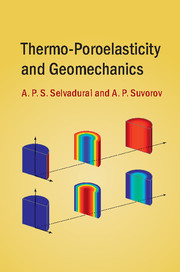Book contents
- Frontmatter
- Dedication
- Contents
- Preface
- Acknowledgements
- 1 Thermo-Poromechanics: Applications and Developments
- 2 Constitutive Relationships Governing Thermo-Poroelastic Processes
- 3 One-Dimensional Problems Involving Thermo-Poroelastic Processes
- 4 Thermo-Poroelasticity of Geomaterial With a Fluid-Filled Rigid One-Dimensional Cavity
- 5 Radially Symmetric Thermo-Poroelasticity Problems for a Solid Cylinder
- 6 Radially Symmetric Thermo-Poroelasticity Problems: Cylindrical Cavity in an Infinite Medium
- 7 Spherically Symmetric Thermo-Poroelasticity Problems for a Solid Sphere
- 8 Spherically Symmetric Thermo-Poroelasticity Problems: Spherical Cavity in an Infinite Medium
- 9 Glaciation Problems Involving Thermo-Poroelastic Processes
- Appendix
- Index
- References
4 - Thermo-Poroelasticity of Geomaterial With a Fluid-Filled Rigid One-Dimensional Cavity
Published online by Cambridge University Press: 10 November 2016
- Frontmatter
- Dedication
- Contents
- Preface
- Acknowledgements
- 1 Thermo-Poromechanics: Applications and Developments
- 2 Constitutive Relationships Governing Thermo-Poroelastic Processes
- 3 One-Dimensional Problems Involving Thermo-Poroelastic Processes
- 4 Thermo-Poroelasticity of Geomaterial With a Fluid-Filled Rigid One-Dimensional Cavity
- 5 Radially Symmetric Thermo-Poroelasticity Problems for a Solid Cylinder
- 6 Radially Symmetric Thermo-Poroelasticity Problems: Cylindrical Cavity in an Infinite Medium
- 7 Spherically Symmetric Thermo-Poroelasticity Problems for a Solid Sphere
- 8 Spherically Symmetric Thermo-Poroelasticity Problems: Spherical Cavity in an Infinite Medium
- 9 Glaciation Problems Involving Thermo-Poroelastic Processes
- Appendix
- Index
- References
Summary
This chapter continues to examine the thermo-hydro-mechanical problems related to the one-dimensional case of deformation. The problem of a fluid-filled layer (cavity) bounded by two parallel planes is considered. This cavity is embedded into the center of a poroelastic region or body. Displacements, fluid and heat flow in this poroelastic region are allowed only in the direction perpendicular to the walls of the cavity. The elastic stiffness of the cavity is assumed to be very large compared to the stiffness of the surrounding poroelastic material and, consequently, the displacement of the cavity can only be due to thermal expansion of the solid material (skeleton) in the cavity. The problem has similarities to the classical hydraulic pulse tests developed by Brace et al. (1968) and Hsieh et al. (1981) and adopted widely for estimating the permeability characteristics of low-permeability geological materials (Selvadurai and Carnaffan, 1997; Butler, 1998; Selvadurai et al., 2005; Selvadurai et al., 2011; Selvadurai, 2009; Selvadurai and Jenner, 2012; Selvadurai and Ichikawa, 2013; Selvadurai and Najari, 2013, 2015; Najari and Selvadurai, 2014; Selvadurai and Selvadurai, 2014).
An instantaneous pressure pulse or temperature change is applied to the volume of the cavity, and the evolution of the fluid pressure in the cavity with time is obtained. The rate of decay of the fluid pressure inside the cavity may allow us to estimate the permeability value of the surrounding poroelastic material. We present an analytical solution to this problem and compare the results with the finite element solution obtained using the ABAQUS™ finite element program.
Problem of Fluid-Filled Rigid One-Dimensional Cavity: Formulation and Solution
Assume that a fluid-filled rigid cavity (or a layer) occupying the region − a≤x≤a is embedded into a poroelastic geomaterial that occupies the region |x| > a (Fig. 4.1). A “rigid” cavity means that the elastic moduli of the cavity are significantly larger than those of the surrounding geomaterial. For example, the solid part of the cavity can be made of steel. The porosity of the cavity is assumed large, close to one, i.e., almost all the volume of the cavity is filled with fluid.
Information
- Type
- Chapter
- Information
- Thermo-Poroelasticity and Geomechanics , pp. 93 - 110Publisher: Cambridge University PressPrint publication year: 2016
